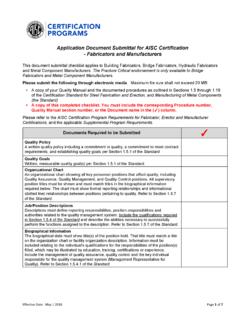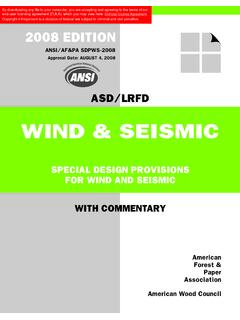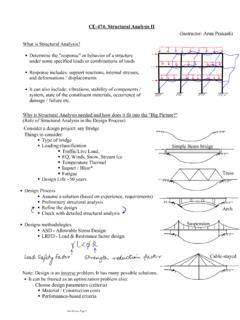Transcription of Specification for Structural Steel Buildings
1 5-11 Specification for Structural Steel Buildings allowable Stress Design and Plastic Design Junel, 1989 with Commentary AMERICAN INSTITUTE OF Steel CONSTRUCTION, INC. One East Wacker Drive, Suite 3100 Chicago, IL 60601-2001 AMERICAN INSTITUTE OF Steel CONSTRUCTION 5-12 PREFACE The AISC Specification /or Structural Steel Buildings allowable Stress Design (ASD) and Plastic Design has evolved through numerous versions from the 1st Edition, published June 1, 1923. Each succeeding edition has been based upon past success-ful usage, advances in the state of knowledge and changes in design practice.
2 The data included has been developed to provide a uniform practice in the design of Steel -framed Buildings . The intention of the Specification is to provide design criteria for routine use and not to cover infrequently encountered problems which occur in the full range of Structural design. The AISC Specification is the result of the deliberations of a committee of Structural engineers with wide experience and high professional standing, representing a wide geographical distribution throughout the U. S. The committee includes approxi-mately equal numbers of engineers in private practice, engineers involved in re-search and teaching and engineers employed by Steel fabricating companies.
3 To avoid reference to proprietary steels, which may have limited availability, only those steels which can be identified by ASTM specifications are listed as approved under this Specification . However, some steels covered by ASTM specifications, but subject to more costly manufacturing and inspection techniques than deemed essen-tial for structures covered by this Specification , are not listed, even though they may provide all of the necessary characteristics of less expensive steels which are listed. Approval of such steels is left to the owner's representative.
4 The Appendices to this Specification are an integral part of the Specification . A Commentary has been included to provide background for these and other provisions. This edition of the Specification has been developed primarily upon the basis of the criteria in the Specification dated November 1, 1978. That Specification , as well as earlier editions, was arranged essentially on the basis of type of stress with special or supplementary requirements for different kinds of members and details contained in succeeding sections. The provisions of the 1978 Specification have been reorga-nized using decision table logic techniques to provide an allowable stress design spec-ification that is more logically arranged on the basis of type of member.
5 This arrangement is more convenient to the user because general design require-ments are presented first, followed by chapters containing the information required to design members of each type. This organization is consistent with that used in the Load and Resistance Factor Design Specification for Structural Steel Buildings . The principal changes incorporated in this edition of the Specification include: Reorganization of provisions to be consistent with LRFD format. New provisions for built-up compression members. New provisions for the design of webs under concentrated forces.
6 Updated provisions for slender web girders. Updated provisions for design for fatigue. Recommendations for the use of heavy rolled shapes and welded members made up of thick plates. AMERICAN INSTITUTE OF Steel CONSTRUCTION 5-13 The reader is cautioned that independent professional judgment must be exercised when data or recommendations set forth in this Specification are applied. The publi-cation of the material contained herein is not intended as a representation or war-ranty on the part of the American Institute of Steel Construction, Inc.
7 Or any other person named herein that this information is suitable for general or particular use, or freedom from infringement of any patent or patents. Anyone making use of this information assumes all liability arising from such use. The design of structures is within the scope of expertise of a competent licensed Structural engineer, architect, or other licensed professional for the application of principles to a particular struc-ture. By the Committee, A. P. Arndt, Chairman E. W. Miller, Vice Chairman Horatio Allison Lynn S. Beedle Reidar Bjorhovde Omer W.
8 Blodgett Roger L. Brockenbrough John H. Busch Wai-Fah Chen Duane S. Ellifritt Bruce Ellingwood Shu-Jin Fang Steven J. Fenves Richard F. Ferguson James M. Fisher John W. Fisher Theodore V. Galambos Geerhard Haaijer Mark V. Holland Ira Hooper Jerome S. B. Iffland June 1989 AMERICAN INSTITUTE OF Steel CONSTRUCTION A. L. Johnson Donald L. Johnson L. A. Kloiber William J. LeMessurier Stanley D. Lindsey Richard W. Marshall William McGuire William A. Milek Walter P. Moore William E. Moore, II Thomas M. Murray Clarkson W. Pinkham Egor P.
9 Popov Donald R. Sherman Frank Sowokinos Sophus A. Thompson William A. Thornton Raymond H. R. Tide Ivan M. Viest Lyle L. Wilson Joseph A. Yura Charles Peshek, Secretary 5-14 TABLE OF CONTENTS A. GENERAL PROVISIONS 5-24 A1. Scope 5-24 A2.
10 Limits of Applicability 5-24 1. Structural Steel Defined 5-24 2. Types of Construction 5-24 A3. Material 5-25 1.
















